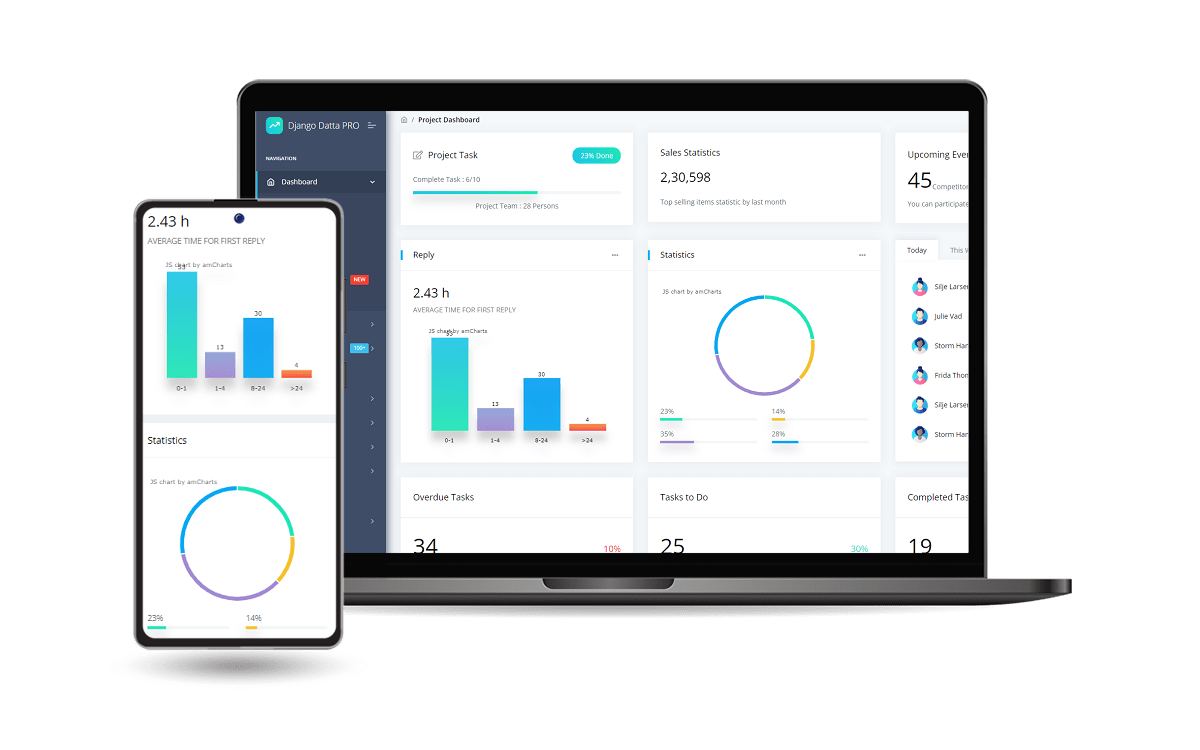Datta Able Enhanced Flask
Premium seed project built in Flask on top of Datta Able Dashboard (Enhanced version).
Premium Flask Dashboard crafted by AppSeed op top of a modern design from CodedThemes.
Datta Able PRO Bootstrap PRO is the most stylised Bootstrap 5 Admin Template, around all other Lite/Free admin templates in the market.
- 👉 Flask Datta Able PRO - product page
- 👉 Flask Datta Able PRO - LIVE deployment
2023-10-08✅ Features
DB Tools: SQLAlchemy ORM,Flask-Migrate(schema migrations)Persistence:SQLite&MySql
Authentication- Session Based (via flask_login)
Social Login(optional) for Github- Automatic suspension on failed logins
Users ManagementExtended user profile- Complete Users management (for
Admins)
APIvia Flask-RestX- Path:
/api/ Products,SalesModels
- Path:
DeploymentDocker- Page Compression via
Flask-Minify(for production)

✅ Environment
To use the starter, Python3 should be installed properly in the workstation.
If you are not sure if Python is installed, please open a terminal and type python --version. Here is the full list with dependencies and tools required to build the app:
- Python3 - the programming language used to code the app
- GIT - used to clone the source code from the Github repository
- Basic development tools (g++ compiler, python development libraries ..etc) used by Python to compile the app dependencies in your environment.
- (Optional)
Docker- a popular virtualization software
✅ Start in Docker
👉 Step 1 - Download & Unzip the code (
requires a purchase)
$ unzip flask-datta-able-enh.zip
$ cd flask-datta-able-enh
👉 Step 2 - Start the APP in
Docker
$ docker-compose up --build
Visit http://localhost:5085 in your browser. The app should be up & running.
✅ Create .env file
The meaning of each variable can be found below:
FLASK_DEBUG:True(development) orFalse(production)- Flask
environment variables(used in development)FLASK_APP=run.py
ASSETS_ROOT: used in assets management- default value:
/static/assets
- default value:
- Persistence: SQLite used by default
- For
MYSQL:- install the driver:
pip install flask_mysqldb - edit
.envDB_ENGINE, default value =mysqlDB_NAME, default value =appseed_dbDB_HOST, default value =localhostDB_PORT, default value =3306DB_USERNAME, default value =appseed_db_usrDB_PASS, default value =pass
- install the driver:
SOCIAL AUTHGithub (optional)GITHUB_ID=YOUR_GITHUB_IDGITHUB_SECRET=YOUR_GITHUB_SECRET
✅ Manual Build
👉 Step 1 - Download & Unzip the code (
requires a purchase)
$ unzip flask-datta-able-enh.zip
$ cd flask-datta-able-enh
👉 Set Up for Unix, MacOS
Install modules via
VENV
$ virtualenv env
$ source env/bin/activate
$ pip3 install -r requirements.txt
Set Up Flask Environment
$ export FLASK_APP=run.py
$ export FLASK_ENV=development
Start the app
$ flask run
At this point, the app runs at http://127.0.0.1:5000/.
👉 Set Up for Windows
Install modules via
VENV(windows)
$ virtualenv env
$ .\env\Scripts\activate
$ pip3 install -r requirements.txt
Set Up Flask Environment
$ # CMD
$ set FLASK_APP=run.py
$ set FLASK_ENV=development
$
$ # Powershell
$ $env:FLASK_APP = ".\run.py"
$ $env:FLASK_ENV = "development"
Start the app
$ flask run
At this point, the app runs at http://127.0.0.1:5000/.
✅ Codebase
The project is coded using a simple and intuitive structure presented below:
< PROJECT ROOT >
|
|-- apps/
| |
| |-- home/ # A simple app that serve HTML files
| | |-- routes.py # Define app routes
| |
| |-- authentication/ # Handles auth routes (login and register)
| | |-- routes.py # Define authentication routes
| | |-- models.py # Defines models
| | |-- forms.py # Define auth forms (login and register)
| |
| |-- static/
| | |-- <css, JS, images> # CSS files, Javascripts files
| |
| |-- templates/ # Templates used to render pages
| | |-- includes/ # HTML chunks and components
| | | |-- navigation.html # Top menu component
| | | |-- sidebar.html # Sidebar component
| | | |-- footer.html # App Footer
| | | |-- scripts.html # Scripts common to all pages
| | |
| | |-- layouts/ # Master pages
| | | |-- base-fullscreen.html # Used by Authentication pages
| | | |-- base.html # Used by common pages
| | |
| | |-- accounts/ # Authentication pages
| | | |-- login.html # Login page
| | | |-- register.html # Register page
| | |
| | |-- home/ # UI Kit Pages
| | |-- index.html # Index page
| | |-- 404-page.html # 404 page
| | |-- *.html # All other pages
| |
| config.py # Set up the app
| __init__.py # Initialize the app
|
|-- requirements.txt # App Dependencies
|
|-- .env # Inject Configuration via Environment
|-- run.py # Start the app - WSGI gateway
|
|-- ************************************************************************
✅ Deploy on Render
- Create a Blueprint instance
- Go to https://dashboard.render.com/blueprints this link.
- Click
New Blueprint Instancebutton. - Connect your
repowhich you want to deploy. - Fill the
Service Group Nameand click onUpdate Existing Resourcesbutton. - After that your deployment will start automatically.
At this point, the product should be LIVE.
✅ Resources
- 👉 Access AppSeed for more starters and support
- 👉 Get in touch for Custom Development Services